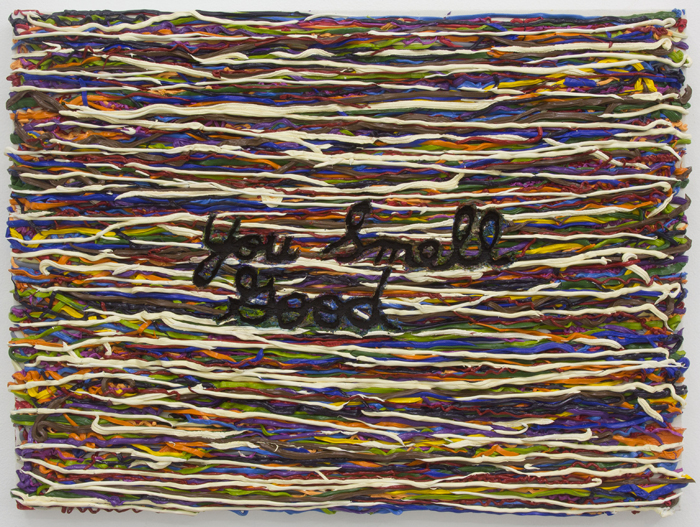The art world revolves around objects, but much of its substance exists in the discourse surrounding those objects—in the myths about artists and expression; the theories devised to understand and evaluate works of art; the rules that determine their commercial value; the viewers’ desires, expectations, and knowledge of art history. The artist-run space, Regina Rex, recently presented The Stuff Things Are Made Of, an exhibition of new and previously-shown works by the late Canadian artist Mathieu Lefevre, who died in 2011, at age 30, while riding his bicycle in Brooklyn. Though narrow in scope, this first posthumous solo show did justice to Lefevre’s work, which playfully considers both the materiality of art objects and the ideas embodied by those objects.
The exhibition took its title from the 2010 painting “The Stuff Things Are Made Of” (not included in the show), in which Lefevre had traced the phrase “The Things Stuff Is Made Of” into a thick layer of paint. By reversing the words “things” and “stuff”, the title establishes a dialog with the art object and with the raw materials used to make it. Much of Lefevre’s work operates in this way, using irony and contradictions to simultaneously consider the things, the stuff, and the viewer’s interpretation of both.
With ten humorous paintings and sculptural pieces and a fold-out poster providing instructions for artists on how to build various “traps” designed to lure in patrons, the exhibition highlighted Lefevre’s ingenious use of materials and his propensity towards playful critique of familiar art tropes. While it is tempting to take Lefevre’s work at face-value, seeing each piece as a simple one-liner, a thorough reading reveals that it is more conceptually sophisticated than it appears.
At the center of the room stood the imposing Monument to Indecision, a recreation of a 2008 piece for which Lefevre had taped together all of the objects that filled his studio at the time, forming a Stonehenge-shaped “monument” that he then photographed. By turning the tools and supplies that he used to make art into a massive new work of art, Lefevre also transformed the uncertainty and frustration that are often part of the art-making process into feelings worthy of commemoration. The version of Monument to Indecision on view at Regina Rex reprised this concept with the things that had been left behind in Lefevre’s studio after his passing, including power tools, musical instruments, cans of spray paint, an easel, an empty beer can, and a print of his photograph of the original piece. Again, the materials had become the work and vice versa.
Several paintings in this show playfully satirized Harold Rosenberg’s interpretation of Abstract Expressionism, which regarded the painterly gesture as an expression of the artist’s psychological, emotional, and physical freedom. In Shit and Natural Phenomenon (both 2011), Lefevre sprinkled cat litter over globs of paint applied on blank canvases, clearly mocking the pretensions of some modern and contemporary art. Those pieces were variations on the even more aptly titled 2010 painting It Just Comes Out Naturally (not included in the show).
Wä Wä Wä Wääää (2011) also considers the shortcomings of Abstract Expressionism and the gullibility of those who buy into it, either literally or figuratively. Over a field of “expressive” brushstrokes in which the colors nearly blend together into a murky brown, Lefevre wrote the web address “www.sadtrombone.com” in thick paint squeezed straight out of the tube. The painting directs viewers to a real website created by bored office workers in North Dakota for the sole purpose of playing “a noise for failure” that can be phonetically spelled out as “wä wä wä wääää”. The self-explanatoryPainting in a Trash Bag Painting (2010) presents a similarly tragicomic view of artistic failure in a more literal way.
Inevitably, and perhaps ironically, over the last two years a myth has been forming around Lefevre and his work, shaping the way this exhibition was perceived by those who knew him or have heard of his fatal accident through the media. While The Stuff Things Are Made Of provided a good introduction to Lefevre`s irreverent sensibility, it only offered a glimpse of his impressive output—some might have expected a retrospective rather than a tightly curated selection of late pieces. Hopefully, by bringing Mathieu Lefevre’s work to the attention of a larger audience (made even larger because the exhibition was on view during the annual Bushwick Open Studios festival), The Stuff Things Are Made Of constitutes a starting point for more exhaustive exhibitions.
By Claudia Eve Beauchesne
























